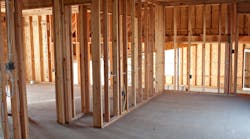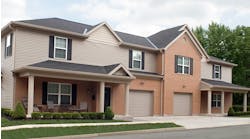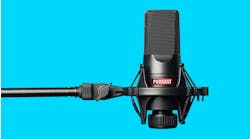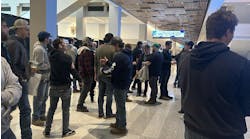Non-metallic (NM) sheathed cable is one of the essential wiring methods found in Chapter 3 of the National Electrical Code (NEC) — see Art. 334. NM cable is used by electricians for wiring single-family dwellings, multifamily dwellings along with their attached or detached garages and storage buildings, mixed-use buildings, and light commercial applications. NM cable has a thermoplastic PVC-coated sheathing/jacket that provides electricians just the right amount of flexibility to pull it through studs, joists, and walls. It also has moderate abrasion resistance.
How to identify wire size, color, and ampacity
In 2001, NM cable with a color-coded jacket was introduced to the market to aid electrical inspectors in identifying the size of the branch-circuit conductors that contractors and electricians used in electrical projects. These color-coded jackets also benefited suppliers and other consumers of electrical wiring products; this system reduced mistakes resulting from the use of incorrect conductor sizes.
The jacket of NM type cable is typically marked with the following information:
- Wire type and designation (e.g., NM, NMC, or NMS)
- Conductor size
- Number of current-carrying conductors (remember, don't count the ground wire)
- Voltage rating (typically 600V)
- Manufacturer’s name
- Time and date it was manufactured
There are no requirements specifying jacket color for a given cable size, but typically the following jacket color(s) are widespread throughout the industry:
- White 14 gauge [14/2, 15A]
- Yellow 12 gauge [12/2, 20A]
- Orange 10 gauge [10/2 (flat cable), 10/3 round cable, 30A]
- Black 8 gauge [8/2 (flat cable), 8/3 round cable, 40A]
- Black or Grey 6 gauge [6/2 (flat cable), 6/3 round cable, 60A]
You can use it here
Type NM cable is permitted for exposed and concealed work in normally dry locations; it cannot be used in wet or damp locations (see Sec. 334.10). When used in exposed work applications, it must not be subject to physical damage. It may be installed or “fished” in the air voids of masonry block or tile walls. When NM cable is used in structures other than dwellings (non-residential), it must be concealed in walls, floors, or ceilings that provide a thermal barrier of material that has at least a 15-min fire rating (e.g., ½-in. drywall), as identified in listings of fire resistance and their rated assemblies.
NM cable is permitted for use in:
- Type I or Type II structures when installed within raceways approved to be used in Type I (fire-resistive) construction [i.e., a building constructed of noncombustible materials (reinforced concrete, brick, stone, etc.) and having any metal members properly “fireproofed” with major structural members designed to withstand collapse and to prevent the spread of fire].
- Type II (noncombustible) construction [i.e., a building having all structural members (including walls, floors, and roofs) of noncombustible materials (reinforced concrete, brick, stone, etc.) and not qualifying as fire-resistive construction].
- TYPE III-A-protected combustible applications (also known as "ordinary" construction with brick or block walls and a wooden roof or floor assembly, which is 1-hour fire-protected).
- Type IV buildings that have noncombustible exterior walls and interior elements. These buildings are made from solid or laminated wood. All wooden members must meet specific dimensional requirements (e.g., wood columns, beams, and girders must be at least 8 in. thick; heavy planks for floors and roofs must be at least 6 in. thick).
- Type V applications: Structural elements, walls, arches, floors, and roofs are wood or other approved material.
Don't use it here
As per Sec. 334.12, NM cable cannot be used as open runs in drop or suspended ceilings in (non-residential) applications other than one- and two-family and multifamily dwellings. It cannot be used in wet or damp locations or as service-entrance cable. It cannot be exposed to corrosive fumes or vapors. It cannot be embedded in masonry, concrete, adobe, fill, or plaster. You cannot install it in a shallow chase in masonry, concrete, or adobe, where covered with plaster, adobe, or similar finish.
Always verify or check the building construction type in consideration or in Annex E of the NEC. If the construction type is approved for NM cable only in raceways, verify the wiring methods permitted in Chapter 5 Special Occupancies. If the building occupancy (Type) allows raceways, you may have an exception to use it; always check with the Authority Having Jurisdiction (AHJ) first before proceeding.
The use of NM cable is also prohibited in these specific NEC Chapter 5 special occupancies:
- Motion picture studios, theaters, and similar locations, except where permitted in Sec. 518.4
- Commercial garages where Class 1 hazardous location liquids or gaseous fuels are stored, handled, or transferred. In these locations, electrical wiring (wiring methods used) and electrical utilization equipment shall be designed following the requirements for Class I, Division 1 or 2 hazardous (classified) locations
- Storage battery rooms
- Hazardous (classified) locations except as permitted in Sec. 501.10(B)(3), Sec. 502.10(B)(3), and Sec. 504.20
- Hoistways or on elevators or escalators
SIDEBAR: Inspector's Choice
How a wiring method is permitted "to be used" in a building is ultimately up to the Authority Having Jurisdiction (AHJ). Inspectors interpret and enforce the requirements outlined in the NEC. It’s your job to verify which edition of the NEC has been "adopted" in the municipality, borough, or state you are working within. In some states, there is no single edition of the NEC being enforced; the various counties, boroughs, and cities use different editions. Other states like Maryland, Delaware, and New Jersey have adopted the NEC on a statewide basis. Some jurisdictions may also have local electrical codes that may supersede the NEC requirements. In some instances, inspectors may have different interpretations of the rules.
Harold De Loach, a master electrician and electrical trainer/instructor, is the founder of The Academy of Industrial Arts (www.taia-school.com) in Philadelphia. With more than 30 years of experience in the field, he writes regular exclusive content for the E-Train and can be reached at [email protected].




